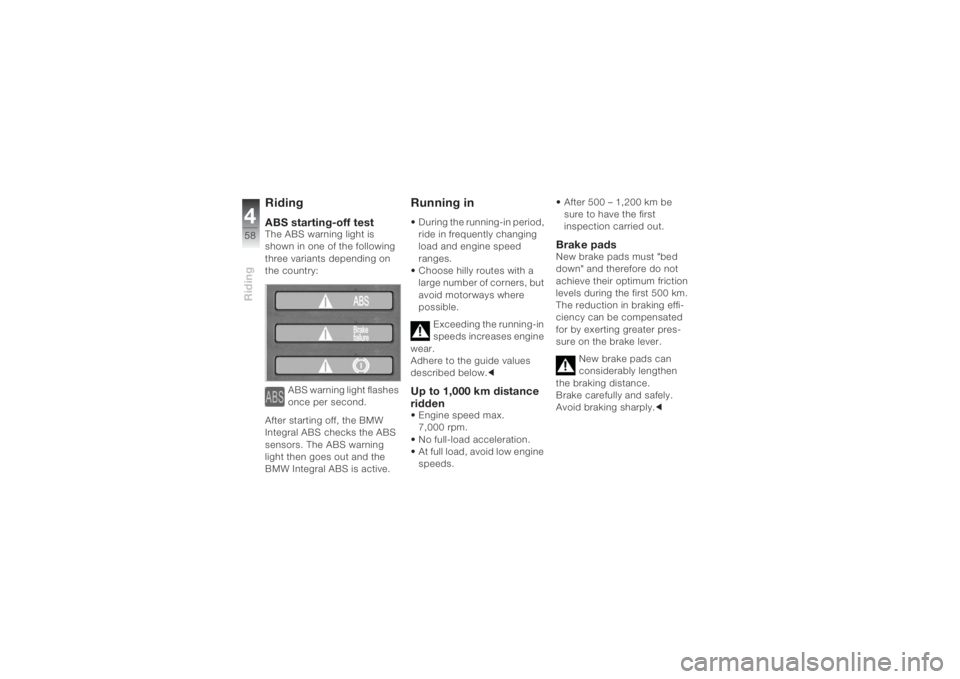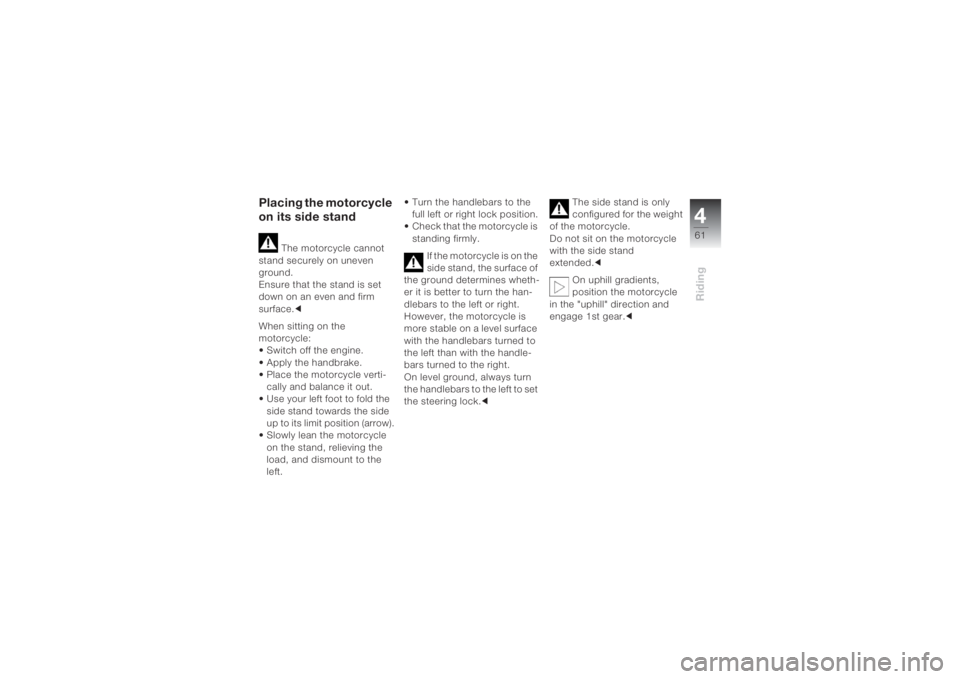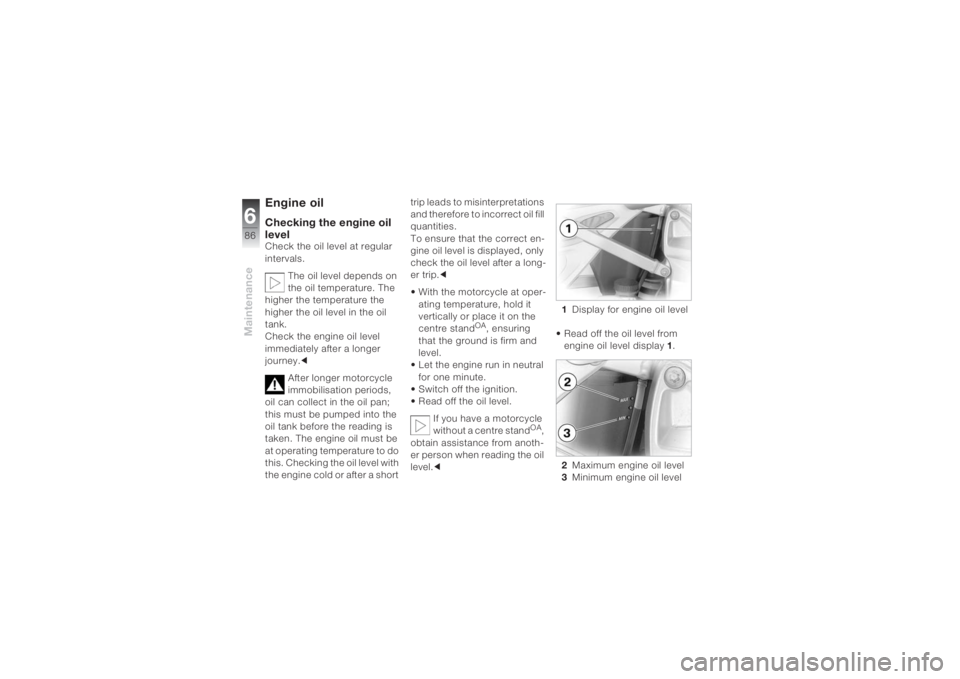Page 60 of 162

Riding458
RidingABS starting-off testThe ABS warning light is
shown in one of the following
three variants depending on
the country:
ABS warning light flashes
once per second.
After starting off, the BMW
Integral ABS checks the ABS
sensors. The ABS warning
light then goes out and the
BMW Integral ABS is active.
Running in• During the running-in period,
ride in frequently changing
load and engine speed
ranges.
• Choose hilly routes with a
large number of corners, but
avoid motorways where
possible.
Exceeding the running-in
speeds increases engine
wear.
Adhere to the guide values
described below.cUp to 1,000 km distance
ridden• Engine speed max.
7,000 rpm.
• No full-load acceleration.
• At full load, avoid low engine
speeds. • After 500 – 1,200 km be
sure to have the first
inspection carried out.
Brake padsNew brake pads must "bed
down" and therefore do not
achieve their optimum friction
levels during the first 500 km.
The reduction in braking effi-
ciency can be compensated
for by exerting greater pres-
sure on the brake lever.
New brake pads can
considerably lengthen
the braking distance.
Brake carefully and safely.
Avoid braking sharply.c
Page 63 of 162

461Riding
Placing the motorcycle
on its side stand
The motorcycle cannot
stand securely on uneven
ground.
Ensure that the stand is set
down on an even and firm
surface.c
When sitting on the
motorcycle:
• Switch off the engine.
• Apply the handbrake.
• Place the motorcycle verti-
cally and balance it out.
• Use your left foot to fold the
side stand towards the side
up to its limit position (arrow).
• Slowly lean the motorcycle
on the stand, relieving the
load, and dismount to the
left.• Turn the handlebars to the
full left or right lock position.
• Check that the motorcycle is
standing firmly.
If the motorcycle is on the
side stand, the surface of
the ground determines wheth-
er it is better to turn the han-
dlebars to the left or right.
However, the motorcycle is
more stable on a level surface
with the handlebars turned to
the left than with the handle-
bars turned to the right.
On level ground, always turn
the handlebars to the left to set
the steering lock.cThe side stand is only
configured for the weight
of the motorcycle.
Do not sit on the motorcycle
with the side stand
extended.c
On uphill gradients,
position the motorcycle
in the "uphill" direction and
engage 1st gear.c
Page 67 of 162
465Riding
Placing the motorcycle
on the centre stand
OA
The motorcycle cannot
stand securely on poor
ground.
Ensure that the stand is set
down on a firm and even
surface.c
• Switch off the engine.
• Dismount, keeping your left
hand on the handlebar grip.
• With your right hand, take
hold of the pillion passenger
grab handle or rear frame.
• Place your right foot on the
actuating pin of the centre
stand and press the centre
stand downwards until the
rolling feet make contact
with the ground.• Place your full body weight
on the centre stand and at
the same time pull the
motorcycle backwards
(arrow).
• Check that the motorcycle is
standing firmly.
The centre stand can fold
in if there is excessive
motion and lead to the vehicle
falling over.
Do not sit on the motorcycle
with the centre stand
extended.c
Page 88 of 162

Maintenance686
Engine oilChecking the engine oil
levelCheck the oil level at regular
intervals.
The oil level depends on
the oil temperature. The
higher the temperature the
higher the oil level in the oil
tank.
Check the engine oil level
immediately after a longer
journey.c
After longer motorcycle
immobilisation periods,
oil can collect in the oil pan;
this must be pumped into the
oil tank before the reading is
taken. The engine oil must be
at operating temperature to do
this. Checking the oil level with
the engine cold or after a short trip leads to misinterpretations
and therefore to incorrect oil fill
quantities.
To ensure that the correct en-
gine oil level is displayed, only
check the oil level after a long-
er trip.c
• With the motorcycle at oper-
ating temperature, hold it
vertically or place it on the
centre stand
OA, ensuring
that the ground is firm and
level.
• Let the engine run in neutral
for one minute.
• Switch off the ignition.
• Read off the oil level.
If you have a motorcycle
without a centre stand
OA,
obtain assistance from anoth-
er person when reading the oil
level.c1Display for engine oil level
• Read off the oil level from
engine oil level display1.
2Maximum engine oil level
3Minimum engine oil level
Page 89 of 162
687Maintenance
The oil level must be located
between the MIN and MAX
marks. The difference is
approx. 0.5 litres.
If the oil level is below the
MIN mark:
• Top up the engine oil.
If the oil level is above the
MAX mark:
• Drain off the engine oil.
Too little or too much
engine oil can lead to
engine damage.
Ensure that the engine oil level
is correct.c
Too little engine oil can
result in the engine seiz-
ing and therefore lead to
accidents.
Ensure that the engine oil level
is correct.c
Topping up the engine oil• Remove the seat (
b 40)
.
• Clean the area around the
filler aperture.
• Unscrew cap of the engine
oil filler aperture 1.• Add engine oil up to the
central markA.
• Check the oil level.
• Repeat the filling and
checking procedure until the
engine oil level is located
between the MIN and
MAX marks.
• Screw on the cap of the
engine oil filler aperture.
Page 90 of 162
Maintenance688
Draining off engine oil • Remove the seat (
b 40)
.
• Press the retainer of clear
hose 2 on the left and right
and pull upwards out of the
oil tank.
• Pull the clear hose down-
wards out of the frame and
drain off the oil into a suitable
container.
• Insert the clear hose in the
oil tank and lock into place.
• Check the oil level.
• Repeat the draining and
checking procedure until the
engine oil level is located
between the MIN and
MAX marks.
• Store or dispose of excess
engine oil in an environmen-
tally-responsible manner.
Coolant Checking the coolant
levelCheck the coolant level at
regular intervals.
1Display for coolant level
• Read off the coolant level
from the coolant display1.
2Maximum coolant level
3Minimum coolant level
The coolant level must be
located between the MIN and
MAX marks.
If the coolant is below the
MIN mark:
• Top up the coolant.
Page 123 of 162
7121
Care
• Place the motorcycle in a dry
room on the centre stand
OA
or rear wheel stand.
• Raise the engine with the
front wheel stand in such a
way that both wheels are
without load.
Before laying the vehicle
up, have the engine oil
and the oil filter element
changed by a specialist work-
shop, preferably your author-
ised BMW motorcycle dealer.
Combine work for laying up/
restoring to use with a mainte-
nance service or inspection.c
Restoring to use• Remove the protective wax
coating.
•Clean the motorcycle
(b 118-120).• Install a charged battery
(
b 115).
• Perform the safety checks
(b 52).
• Check the brakes (
b 89-91).
• Check the tyre pressures
(
b 47).
Page 135 of 162
8133
Technical data
Fuel and lubricantsViscosity classes depending on outside temperature
0 °C – 30 °C SAE 30
20 °C – above 30 °C SAE 40
-15 °C – above 30 °C SAE 15 W-50
-15 °C – 30 °C SAE 15 W-40
-20 °C – 20 °C SAE 10 W-40
-20 °C – 10 °C SAE 10 W-30
-20 °C – above 30 °C SAE 10 W-X (X >
40)
below -30 °C – above 30 °C SAE 5 W-X (X > 40)
Oils with x >
40 are available from your authorised BMW motorcycle dealer.
All engine oils supplied by BMW Motorrad are subject to regular BMW quality assurance checks.
Oil additives are not required and are not recommended.
It is not permitted to mix different engine oils.